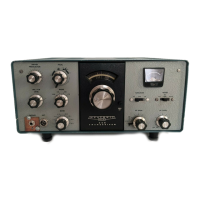8
If the carrier oscillator frequency is placed too far from the filter passband, the receive
and transmit signals will lack “lows” but the opposite sideband rejection will be high. If
the carrier oscillator frequency is placed too close to the filter center frequency, the
receive and transmit signals will have excessive “lows” and the opposite sideband
rejection and carrier suppression will suffer. Balance is the key.
On my particular HW-101, the actual measured carrier oscillator frequencies were 3393.8
kHz LSB, 3395.9 kHz USB, and 3395.17 kHz for CW. This resulted in a “tinny”
sounding audio response in LSB compared to USB, and a very “bassy” sounding USB.
The CW power output while using the SSB filter was 110 watts, but since the CW carrier
oscillator injection was so far from the CW filter center-frequency of 3395.4 kHz, the
CW power output was 50 watts while using the CW filter!
Heath’s intended frequencies for the carrier oscillator were 3393.6 kHz LSB, 3396.6 kHz
USB, and 3395.4 kHz for CW. With the specified filter center-frequency of 3395.0 kHz
the USB & LSB carrier positions would be 1.6 kHz each side of the filter center-
frequency. Unfortunately, the filter center-frequency may not be exactly 3395.0 kHz, so
simply placing the carrier injection points equally-spaced from 3395 kHz may not have
the intended result. In order to determine the filter center-frequency one must balance the
audio response between both sidebands, measure the USB and LSB carrier frequencies,
and finally subtract ½ the difference between the USB & LSB frequencies from the USB
carrier frequency. The result will be the I.F. filter center-frequency as it exists within
your particular rig. For example, if the audio response is exactly the same between
USB/LSB, and the measured USB carrier frequency is 3396.31 kHz while the LSB
carrier frequency measures 3393.51 kHz, then the difference is 3396.31 - 3393.51 = 2.8
kHz. One-half the difference is 2.8 ÷ 2, or 1.4 kHz. Then the USB frequency of 3396.31
kHz - 1.4 kHz = 3394.91 kHz, which in this example is the actual SSB filter center
frequency.
I like audio with a tad bit more bottom end response, so I placed my carrier points just a
little closer to the filter center frequency than the Heath spec., i.e., rather than 1.6 kHz off
center I went with 1.4 kHz. The frequency of the oscillator is lowered by placing a small
amount of capacitance in parallel with the crystal, and the frequency is raised by putting
capacitance in series with the crystal. To put a capacitor in series with the crystal simply
cut one circuit board trace just before the crystal pin as indicated, and solder the capacitor
across the opened trace (Figure 4). A 100 pf capacitor in series will move the crystal
frequency up about 100 Hz, but the same frequency change in the downward direction
would only require about 10 pf connected in parallel with the crystal.
On my HW-101 I put the capacitors (silver mica’s) directly on the circuit board foils. I
got one sideband to sound the way I liked, and then simply adjusted the other sideband to
match it in audio response. I wound up using a 10 pf cap in parallel with the LSB crystal,
100 pf in series with the USB crystal, and 80 pf in series with the CW carrier crystal.
Following these changes, the new carrier oscillator frequencies for my rig are 3393.51
kHz LSB, 3396.31 kHz USB, and 3395.38 for CW. The audio is perfectly balanced
when switching between sidebands, indicating a true I.F. filter center frequency of

